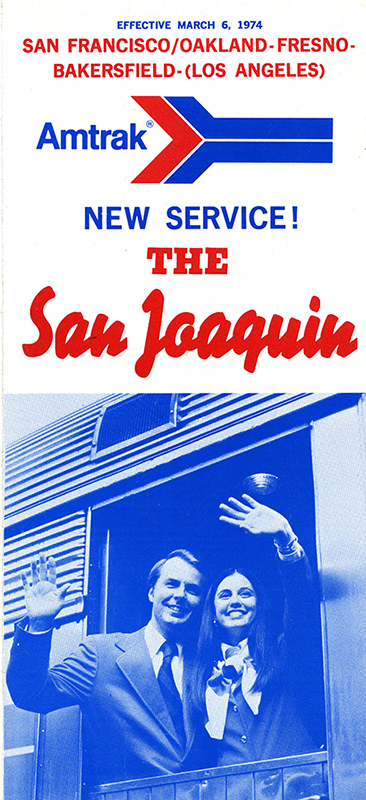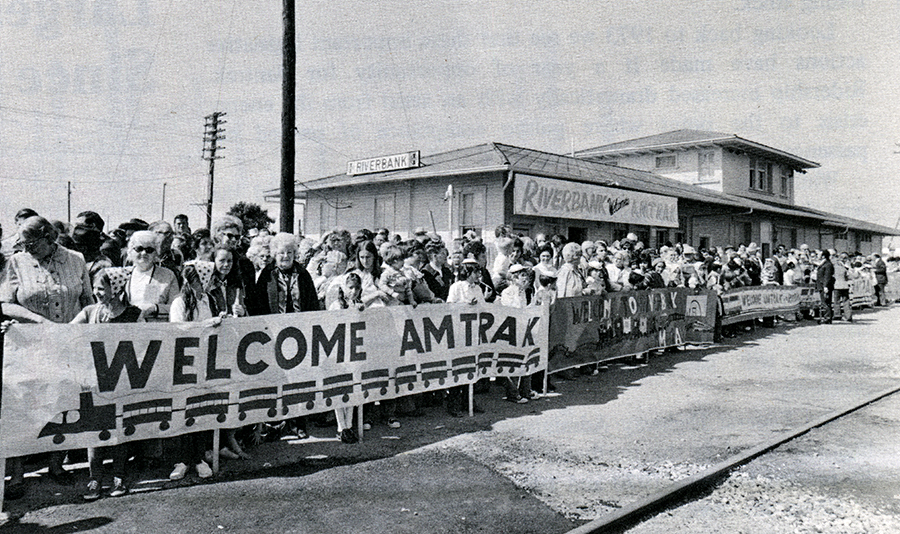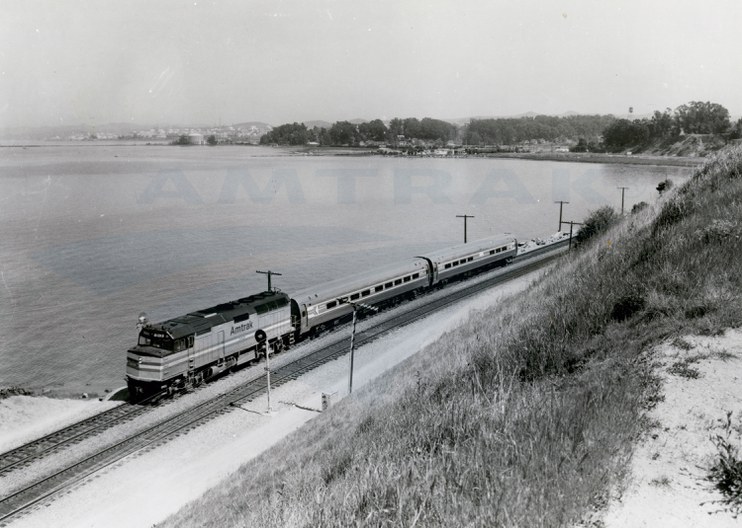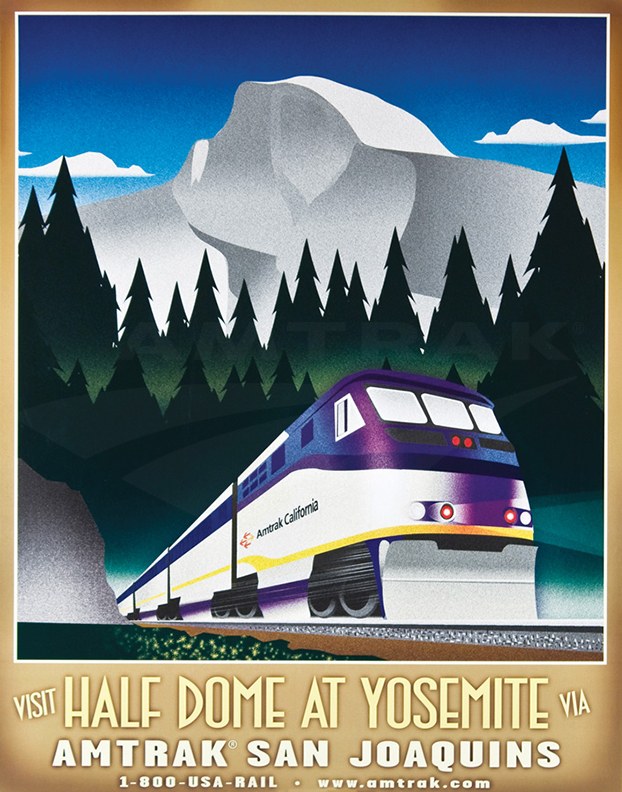Reconnecting the San Joaquin Valley
CommentsFebruary 23, 2018
In early March 1974, residents of the San Joaquin Valley – one of the world’s most productive agricultural regions, running the length of the California interior between Los Angeles and San Francisco – welcomed the return of regularly-scheduled intercity passenger rail service for the first time in nearly three years.
Prior to the start of Amtrak service in May 1971, valley communities had long been served by trains of the Southern Pacific Transportation Company (SP) and the Atchison, Topeka and Santa Fe (Santa Fe). These respectively included the San Joaquin Daylight (Los Angeles-Oakland) and the San Francisco Chief (Chicago-Richmond).

Like other railroads facing competition from new interstate highways and the aviation network – largely planned and constructed with federal funds – that lured passengers to the roads and skies, the SP and Santa Fe had decided to turn over their diminished passenger operations to Amtrak. The company had been established by an act of Congress in 1970 to take over the majority of the nation’s passenger rail service.
The U.S. Secretary of Transportation sketched out a basic national system for Amtrak with defined route endpoints – but Amtrak was left to decide the exact routings. It considered factors such as population centers served, condition of the infrastructure and operating costs.1 In California, Amtrak decided to route all services between Los Angeles and the San Francisco Bay area along the SP’s Coast Line via Santa Barbara. Amtrak noted in 1971 that this route “serves more population than the [San Joaquin] valley alternative through Fresno…is two hours faster [and] more scenic…and ridership is almost twice that of the valley route with much greater through ridership.”2
Almost as soon as the last Santa Fe and SP passenger trains moved through the San Joaquin Valley in the lead up to the start of Amtrak service on May 1, residents and civic leaders began advocating for inclusion in Amtrak’s national network. Their multi-year efforts at the state and federal level paid off when the U.S. Department of Transportation appropriated funds in the 1973-74 budget for a daily (San Francisco)-Oakland-Bakersfield-(Los Angeles) roundtrip.3
This and other additions to the Amtrak system came at a time when the company was experiencing record ridership. The 1973-1974 OPEC Oil Embargo, which caused gasoline shortages, had encouraged Americans to try the train.
The aptly named San Joaquin began revenue service on March 6, 1974; a day earlier, the special inaugural train left the San Francisco Bay area “with over 100 state and local officials and the news media on board,” noted an Amtrak press release.4 Special ceremonies were scheduled at stops along the 312-mile route to Bakersfield.

Crowds await the first revenue run of the San Joaquin at Riverbank, Calif., on March 6, 1974. This station was replaced in 1999 by a new facility at Modesto.
Amtrak chose the Santa Fe route through the valley, switching to the SP at Port Chicago on Suisun Bay to access Oakland. Dedicated buses transported customers to San Francisco and Los Angeles, and customers could also connect to the Coast Starlight (Los Angeles-Seattle) at Oakland.
Like most early Amtrak services, the San Joaquin used a variety of equipment that the company bought or leased from the predecessor railroads. Trains generally had three to five cars, including a lunch counter car and coaches.5 In 1976, the service received gleaming new single-level Amfleet cars, which Amtrak had begun deploying across the system a year earlier.
In response to the Amtrak Improvement Act of 1978, the U.S. DOT examined all routes for costs, ridership, tourism potential, transportation alternatives and other factors, to determine which should remain in a reduced national system. The San Joaquin, which in 1978-79 carried nearly 88,000 customers, was identified for elimination.6
With preservation of the service in mind, the state of California entered into a partnership with Amtrak to provide funding to help cover operating costs. This arrangement was allowed under section 403(b) of the act that created Amtrak. It also meant the state began to take an active role in managing the service.
California soon requested another roundtrip to give customers greater choice and flexibility. The second train was added to the schedule in February 1980, and within a year, ridership increased 41 percent.7 The state also focused on creating and funding dedicated bus connections (with guaranteed seating) that extended the reach of the San Joaquins and provided a seamless travel experience for customers.
Since the creation of the Amtrak-California partnership, the number of daily San Joaquins roundtrips has grown to seven, and stations served increased from eight to 18. In fiscal year 2017, the San Joaquins constituted the sixth-busiest Amtrak corridor in the country, accommodating more than 1.1 million customer trips.
Five roundtrips operate between Oakland and Bakersfield and two between Sacramento and Bakersfield. The latter began in February 1999, when a new roundtrip provided the first direct rail link from the San Joaquin Valley to the state capital since 1971. “After a span of 28 years, we believe passengers are more than ready to park their cars and take the train,” said Jose Medina, then-director of the California Department of Transportation.8
Instead of continuing west at Stockton, the train headed north to Sacramento. The track configuration through downtown Stockton meant that the Sacramento trains could not stop at the (former Santa Fe) San Joaquin St. station, and instead use the (former SP) Cabral Station located to the northeast.
Since the mid-1990s, the San Joaquins have primarily employed state-owned bi-level "California cars” modeled after the earlier Superliners. They wear a distinctive blue, gold and orange paint scheme and have two sets of automatic doors to speed boarding and alighting. Customers enjoy spacious coach seating and a café car that carries sandwiches, salads, snacks and a variety of beverages.

With San Pablo Bay again a backdrop, a San Joaquin train with California cars passes through Pinole, Calif.
Today the San Joaquins service is financed primarily through funds made available by the San Joaquin Joint Powers Authority (SJJPA) through the California Department of Transportation. In 2015, the SJJPA, composed of 10 regional government agencies, assumed administration and management of the San Joaquins, which Amtrak continues to operate.
The SJJPA gives San Joaquin Valley residents and train riders a greater voice in decisions affecting the rail service – harkening back to the broad popular support that helped launch the San Joaquins more than four decades ago.
Do you have a favorite memory of traveling on the San Joaquins? Share it with us in the comments section.
1 National Railroad Passenger Corporation, Annual Report (Covering the Period October 30, 1970 – October 29, 1971), 1971.
2 Ibid.
3 State of California Department of Transportation, Rail Passenger Development Program, 1984 through 1989 Fiscal Years, 1984.
4 National Railroad Passenger Corporation, (Press release ATK-74-10), 1974.
5 Fred W. Frailey, Zephyrs, Chiefs and Other Orphans, (Godfrey, Ill.: RPC Publications, 1977).
6 State of California Department of Transportation, Rail Passenger Development Program, 1984 through 1989 Fiscal Years, 1984.
7 Ibid.
8 National Railroad Passenger Corporation, “Amtrak California Adds Fifth San Joaquin Train Feb. 21” (Press release ATK-99-29), 1999.






